

|
Soundclip:
|
| See Steve's Hand-Written Solo Transcription |
|
Steve Khan's solo on: "Naan Issue"(Steve Khan) Of course, I would love to believe that, those of you who are visiting this particular page for the first time, you would have already read the analysis page for the compositional aspects of "Naan Issue." But, I'm going to assume that most of you have not done that. So for some of you it might seem as though I am repeating some elements from that page. 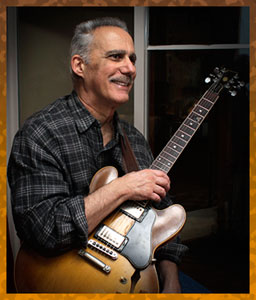 This was the 1st tune that we recorded on March 18th, 2019, perhaps because playing a cha-cha-cha is the easiest of all the Latin rhythms? The format had been neatly laid-out and discussed, and we all knew that there would be a 6 chorus solo, and that on Chorus 4, Rob Mounsey's keyboard would then join in. At that point, two other elements, huge favorites of mine would also enter the musical picture. Though he could have easily stayed on his cha-cha bell on the timbal, Marc Quiñones moved to his mambo bell, which coincides with the entry of the campana on the right side of this stereo mix. During a cha-cha this doesn't often occur, but I have loved this ever since I first heard it done on Ray Barretto's classic tune, "Cocinando." If you are new to this tune, the campana enters when the trumpet solo begins. For "Naan Issue," at that same moment, also giving the flow of the solo a huge lift, drummer Dennis Chambers switches to the bell of his ride cymbal and bangs out a rhythm that I first heard on Cal Tjader's "Soul Motion" from "SOUL BIRD"(Verve)(1965). When Dennis forgets what the pattern is, I just sing it to him, and gesture with my hand, "spang, spang, spang-a-dang | spang, spang, spang-a-dang." This is usually followed by laughter from anyone and everyone who could hear me. This was the 1st tune that we recorded on March 18th, 2019, perhaps because playing a cha-cha-cha is the easiest of all the Latin rhythms? The format had been neatly laid-out and discussed, and we all knew that there would be a 6 chorus solo, and that on Chorus 4, Rob Mounsey's keyboard would then join in. At that point, two other elements, huge favorites of mine would also enter the musical picture. Though he could have easily stayed on his cha-cha bell on the timbal, Marc Quiñones moved to his mambo bell, which coincides with the entry of the campana on the right side of this stereo mix. During a cha-cha this doesn't often occur, but I have loved this ever since I first heard it done on Ray Barretto's classic tune, "Cocinando." If you are new to this tune, the campana enters when the trumpet solo begins. For "Naan Issue," at that same moment, also giving the flow of the solo a huge lift, drummer Dennis Chambers switches to the bell of his ride cymbal and bangs out a rhythm that I first heard on Cal Tjader's "Soul Motion" from "SOUL BIRD"(Verve)(1965). When Dennis forgets what the pattern is, I just sing it to him, and gesture with my hand, "spang, spang, spang-a-dang | spang, spang, spang-a-dang." This is usually followed by laughter from anyone and everyone who could hear me.What is going to drive any piece of music, especially in Latin music, is going to be the tumbao or the groove, the feel. Here, this comes from Bobby Allende's conga, and the immense sound and feel from Rubén Rodríguez' Baby Bass. They keep the time with great precision, but also feel free enough to interact and musically converse with all the other elements and players present. Sometimes, things can be made so easy for you that you have to stop for a moment and thank your lucky stars that you are surrounded by true giants in the idiom. My respect and admiration for all of these players knows no bounds! Over the run of these recent albums, and we could say that this goes back to 2005 and "THE GREEN FIELD," my sound and my set-up has remained pretty much in tact. Though, prior to the recording of "SUBTEXT"(2014), I did have Tom Peck completely redesign my old pedalboard. But, other than that, the gear remained the same. I have often received fan mail asking me questions about my equipment, and fortunately, I have always taken photos of what everything looked like prior to actually recording. With "PATCHWORK" this was no different. However now, instead of waiting for the e-mails to come, I have created a page at the website where you can view the photos of my set-up, and even see the microphones, as meticulously placed by engineer James Farber. If you just click on the smaller image that is right next to this text, it will take you to that very page. 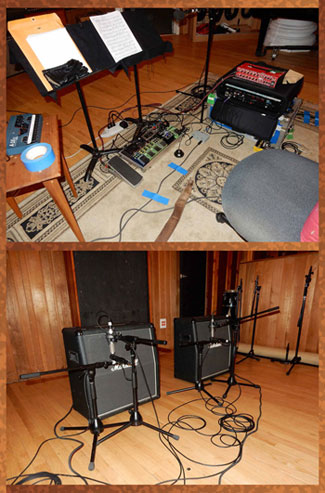 I am hopeful that you will find it helpful and instructive. I am hopeful that you will find it helpful and instructive.When I was preparing for this new recording, I tried to compose some kind of an original blues. How hard could that be? For me, it wasn't so easy. How is it possible that I couldn't even compose an acceptable blues?!?!?! What the hell was wrong with me? I was so frustrated. But, one day, as I was trying to come-up with an interesting teaching strategy for a particular student of mine, who has always been a blues player, my mind and memory drifted back to Wes Montgomery and his original blues in Eb, which was the title song from his 1960 album, "MOVIN' ALONG"(Riverside). At that point, I did not have a cha-cha-cha on this album, and so, I decided that that would be the rhythmic approach for "Naan Issue." Taking Wes' basic chord changes, I laid-out the piece, and eventually came-up with a melody that resonated with me. Wes' tune was, in terms of length, a traditional 12-bar blues. Here, "Naan Issue" became a 24 bar blues, which is comprised of all very lush sonorities that I would describe as 7(9sus) sounds, or minor 9sus sounds with the 4th in the bass. For example, for our I7 chords, you could label them as Bbm7(9)/Eb - that as opposed to Eb7(9sus). Either way, the result is the same. One of the most important elements in Latin music is the art of the percussion break, which can occur at any number of moments during a particular tune. I count on Marc and Bobby to come-up with the breaks as needed. What they invariably add gives my albums a sabor that they would not have otherwise. A cha-cha would certainly not be such without Marc's signature avanicos, which happen throughout the piece, but the first of the breaks occurs after the melody, and is played underneath Rob's big Rhodes breakdown. From Marc, Bobby and Dennis, it begins by recalling Dizzy Gillespie's classic "Salt Peanuts"! But, in a unique Bobby Allende-created twist, there's a flurry of unison notes that actual begin on beat 1 of Solo Chorus 1. Bobby created this break very spontaneously, and then shared it with Marc and Dennis. When it came together, it was fantastic. Another important touch leading into the solo is Rob's dreamy arpeggio with a pedal sustain that carries over until one last accent on the and-of-2 of bar 4. I asked Marc to catch it, and he does that using only the bell of his main cymbal. Now, finally let's talk about the 6 chorus solo as it unfolded. As the solo begins, for Chorus 1, the texture completely thins out, and it becomes fundamentally just two moving lines, the guitar and the bass, a setting that I have felt most comfortable in since the earliest days of Eyewitness. This allows me both the linear freedom to let the lines take their course, but also to interject chordal sonorities that reflect the way that I hear harmony on the guitar, and how it can suggest colors when the bass allows you this kind of freedom. This is where Rubén's ears and support are so vital to everything that I played on this recording, and the others that have preceded it. Sometimes the playing of one of your heroes is so ingrained into your very being that bits and pieces can emerge at any time. The 1st phrase of the solo is just such a moment as it is a paraphrase of something that Wes Montgomery played in his original solo, and here it becomes a small tribute to the kind of very melodic player that he was. That phrase, from a modal perspective is drawn from Bb Dorian [Bb, C, Db, Eb, F, G, Ab] and extends right to the pivotal bar 8, where the b5 sub of A7 is tied into the solo changes. As I transit to bar 9 and the arrival of IV7 chord, I am actually playing notes from B dominant 7th pentatonic [B(#5), C#/Db, D#/Eb, F#/Gb(#9), A(b5)] which gives me 3 of the all important altered tones. But, none of this cerebral nonsense is worth anything UNLESS this becomes the way that you HEAR things. For me, it has become second nature. As I land on bar 9, and the Ab9(sus) chord, you can hear that I am alluding to elements from the melody where the target note of Ab is surrounded by its chromatic upper and lower neighbors. The rest of the phrase in bars 9-12 is blues-based with the insertion of a Gb triad in bar 11 that gives you some lush color tones: 7th-9th-11th. As we return to the I7 chord with short Bb on beat 1 in bar 13, as I hit bar 14, the Eb is surrounded by its chromatic upper and lower neighbors, which again serves to tie the solo to melodic material that was previously revealed. The line in bar 16 is of interest because I have surrounded the Ab with its chromatic upper and lower neighbors before playing a line that combines chromatic elements of Bb Dorian with Bb minor pentatonic [Bb, Db, Eb, F, Ab]. Bars 17 through 22 present a passage in chords that is really my impression of the way Chick Corea was playing Latin music on Cal Tjader's legendary album "SOUL BURST," an album that changed my musical life. Over the F#m7/B chord, I am playing voicings that are both F#m7 derived but also B7(13) oriented. You could say that this style owes a lot to McCoy Tyner and Herbie Hancock too. This chorus comes to a close beginning with the phrase in bar 22 which is tied to the first notes of the main melody and the very first phrase of the solo. The first 5 bars of Chorus 2 offer a continuation of the melodic chordal passages that, because of the C up to Db in parallel harmony, are still tied to the principal melody. The two parallel voicings in bar 6 leave us, for a moment, in an area that is now 1/2-step above what is consonant, and you could say that it is an F#m7(sus) voicing. This leads to a fragment in bar 7 of F# minor pentatonic [F#, A, B, C#, E] that quickly resolves to a Bb minor pentatonic fragment that brings us back from what might have seemed outside of the tonality. In bar 8 where the A7 is transiting to Ab7(9sus), I am using E Dorian [E, F#, G, A, B, C#, D] with a touch of chromaticism to lead me down to an Eb over the IV7 chord in bar 9. In bar 10, for rhythmic variety some triplets appear putting to use both Ebm and Bbm triads over the Ab7(9sus) leading to Eb-Db-Eb - and notice the long-short phrasing at the end. Bar 12 brings us back to our I7 chord by using an Ebm triad into Bb minor pentatonic resolving to a Bb. Then, in bar 14 on beat 2, we have our first bent note with vibrato, a higher Db, which then leads me to a jagged line that combines Eb minor pentatonic [Eb, Gb, Ab, Bb, Db] - but here it could be easily viewed as blues-related material. Then, on beat 2, suddenly I'm in either F# or Gb minor pentatonic [F#, A, B, C#, E] resolving to what could be seen as C minor pentatonic [C, Eb, F, G, Bb] ever so briefly over the Eb7, but it is consonant. In bar 16, the notes are from F minor pentatonic [F, Ab, Bb, C, Eb] giving a nice flavor over the basic chord of Eb7(9sus). In bar 17, over the F#m7/B chord, I am employing both C# minor pentatonic [C#, E, F#, G#, B] and F# minor pentatonic [F#, A, B, C#, E]. 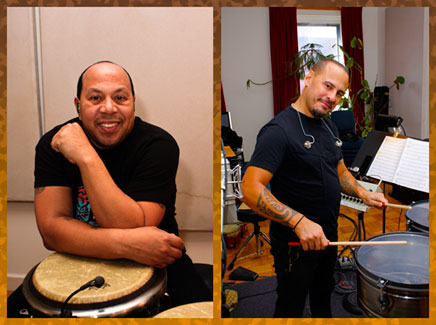 In bar 18, I am already in motion to the Fm7/Bb chord with some descending chromaticism, played behind the beat and leading me to F Dorian [F, G, Ab, Bb, C, D, Eb]. Finally, this chorus reprises its opening chordal phrases before closing with a sequence of parallel voicings that harmonize the top voices of F, G, Ab, and Bb. But, because of the colors in that particular voicing, you have inner voices that touch upon notes that are outside of the tonality like: Fb, Cb, and Gb. This is something that one must really hear and believe in - otherwise, no one else will believe it!!! In bar 18, I am already in motion to the Fm7/Bb chord with some descending chromaticism, played behind the beat and leading me to F Dorian [F, G, Ab, Bb, C, D, Eb]. Finally, this chorus reprises its opening chordal phrases before closing with a sequence of parallel voicings that harmonize the top voices of F, G, Ab, and Bb. But, because of the colors in that particular voicing, you have inner voices that touch upon notes that are outside of the tonality like: Fb, Cb, and Gb. This is something that one must really hear and believe in - otherwise, no one else will believe it!!!The activity begins to pick up in Chorus 3 with groupings of double-time 16th-notes. In bars 1-2, you have notes from Bb minor pentatonic, but the tag of the phrase in bar 2 gives you a B-natural which is the chromatic upper neighbor to Bb. This is something I got used to hearing standing next to, and listening to both Randy and Michael Brecker improvising, and it always made sense to me, musically and emotionally. Bars 3-4 continue along these lines, but in the 2nd-half of bar 3, you have the application of the Bb blues scale [Bb, Db, (D), Eb, E, F, Ab], and the tag of this phrase surrounds our root(Eb) with its chromatic upper and lower neighbors which continue to tie the solo to our melody. Once again, in bars 5-7, I am playing phrases purposely behind the beat, and ending with a bluesy phrase that features both Gb and C-natural. You could say that this is material derived from the bluesier aspects of C minor pentatonic. In bar 8, as we travel to the IV7 chord via the A7 substitute, I am using B minor pentatonic [B, D, E, F#, A], which resolves itself from A to G, though all of these notes could be seen as being part of E Dorian. Pay special attention to the fantastic fill by Marc! In bar 9, as we hit our IV7 chord, Ab7(9sus), because this is, after all, a blues, I am still in the blusier area of C minor pentatonic with an emphasis on using Gb as my blue note. In bar 12, the bluesy nature continues as I use a very basic Ab minor pentatonic [Ab, Cb, Db, Eb, Gb], but this is a moment where I would want to point out just how really rich and full my low Ab sounds on this recording. You can tell that I am pushing those Marshalls as hard as I can with this big, warm guitar sound, and they simply respond, never giving in to any kind of distortion. It is one of those moments where I realize what a great engineer James Farber is. From bars 13 through 24, the chorus concludes with a long chordal passage. If I must remind you all, to me, these are NOT just a 'bunch of chords' because I hear the top voice of each one as a melody note. This is crucial when playing like this - at least for me! In bars 13-16, once more, parallel harmony is put to use, but this time with simple triads harmonizing the top voice as they pass from Eb(Ab triad)-Db(Gb triad)-C(F triad). In the answer to that phrase in bars 15-16, they finally resolve to a Bb(Eb triad). It seems so simple, but it gives a rather majestic feeling to the harmony. In bars 17-18, over the F#m9/B, where the texture is wide open and Rubén is giving me the basic notes, I can play voicings that allude to B7(13b9) in parallel, and to me, it sounds great. To answer that phrase, in bars 19-20, I am playing a voicing that I grafted on from Chick Corea where they are parallel 7#9 voicings with a nice space between the #9 and the top voice of the root. But everything is played in parallel, and it never sounds dissonant to me. The chorus concludes in bars 21-24 with harmonies that to me provide a sense of applying Bbm7(sus) voicings over the Eb's that expand the sense of richness to the linear harmonic palettte. 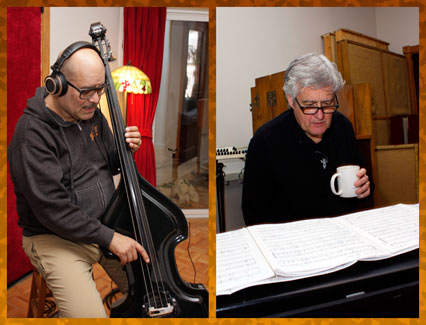 There is a nice touch in bar 24, where I reharmonize the top voice of Ab by moving up the inside voices from F-Bb-Eb to Gb-Cb-Fb and finally it all goes up to Ab-Db-Gb-Bb. This mixes the consonant with the dissonant, but because the top voices can all be seen as being within the blues language, thus the ears accept it. There is a nice touch in bar 24, where I reharmonize the top voice of Ab by moving up the inside voices from F-Bb-Eb to Gb-Cb-Fb and finally it all goes up to Ab-Db-Gb-Bb. This mixes the consonant with the dissonant, but because the top voices can all be seen as being within the blues language, thus the ears accept it.
The arrival of Chorus 4 has Dennis Chambers moving to the bell of his ride cymbal, and it signals the entrance of Rob Mounsey's keys. For those of you who are fascinated by this kind of keyboard harmony, you only have to visit the KEYBOARD COMPING LEAD SHEETS pages and everything is there for you. As for the solo, the opening on beat 1 continues to use the thematic piece of chromatic upper and lower neighbors to surround important notes. From there, in bars 2-7, Wes Montgomery is paraphrased again with another memory of his great solo on his original version. In bar 8, an A7 chord is spelled-out in triplets, before anticipating the coming IV7 chord of Ab7(9sus). Once bar 9 is upon us, the blues return with combinations of using the bluesy side of C minor pentatonic, and also F minor pentatonic with a nice bent note Bb with vibrato in bar 12. The same bluesy feeling continues in bars 13-16, including the usage of Eb minor pentatonic in bar 15 - which is so close to the Eb blues scale [Eb, Gb, (G), Ab, A, Bb, Db] that, in context, it can be hard to say which is which. In bars 17-20, the linear approach becomes more modal as we see notes from F# Dorian [F#, G#, A, B, C#, D#, E] played with a very laid-back feeling. Where phrasing is concerned, pay attention to the little 16th-note triplet grouping on beat 1 of bar 17. These small details can go by so quickly that they are not noticed, but it is so important to maintaining the feeling of Jazz even in an even 8th-note rhythmic groove. In bars 19-20 over the Fm7(9sus)/Bb, you hear notes from F Dorian with the added touch of G-D-B-natural at the end, which comes from Bb7(13b9) and linearly pulls us back to our I7 chord resolution. As the chorus closes out, the bluesy feeling intensifies as I am hitting away at Ab's and Bb's, until there's a little flurry of 16th-notes in bar 24 derived from F minor pentatonic. At Chorus 5, as Rob's keyboard goes up in register, so do I, alternating between the bluesy areas of Eb and F minor pentatonic. However in bar 4, there is a quick descending passage of 16th-notes from C minor pentatonic. In bars 5-7, I am again playing purposely behind-the-beat using a chromatic blues-based phrase. In bar 8, over the now expected A7 sonority, I am applying E Dorian as I resolve to Ab7(9sus) on the note, Bb. Notice how the usage of a simple Gb triad adds rich colors to the line. In bar 12, it sounds like I was having an Eddie Harris moment, as this line reminds now a bit of his great tune, "Listen Here." In bars 13-16, over Eb7(9sus) it's back the blues language, preceded by a quick 'sweep' through a Db triad. As the F#m7(sus)/B arrives in bar 17, there's a quick flurry of 16th-notes that combines elements of F# Dorian and C# minor pentatonic. Then, in bars 19-20 over Fm7/Bb, that feeling of playing behind the time returns using F Dorian as a base.  The final 4 bars of the chorus are devoted to blues-based phrases over the I7 chord with the emotional emphasis on the most basic notes: Ab(4th) and Bb(5th), and then Gb(the blue note) bent up ever so slightly. The final 4 bars of the chorus are devoted to blues-based phrases over the I7 chord with the emotional emphasis on the most basic notes: Ab(4th) and Bb(5th), and then Gb(the blue note) bent up ever so slightly.For Chorus 6, the finale of the solo, I spend the first 8 bars playing a high bent-note Eb on beat 2 of every odd-numbered bar. That bent note is answered by a 16th-note grouping in the even-numbered bars. You can't help but notice that the brilliantly creative and fiery Marc Quiñones sensed what I was going to do, and then, he set-up each hit with a wondrous timbal fill. In bar 2, the 16th-notes are right out of Eb minor pentatonic, but again, in that zone where it is so close to the blues scale that there is hardly any difference. In bar 4, the phrase that answers is slightly different but drawing upon the same language. From a guitar/audio perspective, I love the fact that the last note, a lower Gb is played on my low E-string, and there is still not a hint of wobble from the Marshall speakers. The 16th-note phrase in bar 6 is similar, but with the last part of the phrase being different from all that have come before. Finally, in our bar 8, I go way up in register to a high Gb and descend in the same Eb minor pentatonic, but this time, on beat 3, I shift to E minor pentatonic to observe the b5 sub of A7(9sus). It makes such a nice contrast to everything that had gone on before. How one does such things is all a matter of taste and instinct. For the Ab7(9sus) in bars 9-12, it feels as though I was in more of a Eb minor pentatonic place for the first 2 bars, where there is a great percussive moment between Bobby and Marc and the triplets that Bobby played - the final piece to this moment was Marc responding later as well on the campana making for a wonderful stereo audio experience. In bars 11-12, that laid-back feeling returns, and the notes reveal a rather unique path to returning us to our I7 of Eb7(9sus). Notice the D-natural to Db in the middle of the phrase! Bars 13-16 keep us grounded in the blues language with subtle touches on the blue note of Gb bent-up ever so delicately. In bars 17-18 over F#m7/B, the phrase is right out of F# Dorian - and do take note of the phrasing mannerism on beat 1, the grouping of 8th-note/2 16th-notes, as this is a classic part of the Jazz language. When such things are not there, a listener, a fan of the genre, really notices it! Over the Fm7/Bb, the mode simply goes down a 1/2-step to F Dorian, with the time feel being behind-the-beat. It would not have been right if this particular solo hadn't finished off in the blues-based language that makes a blues, a blues! And so, the final phrases are all in that Eb blues area with the very last note being slid up to a high Gb on the B-string and gently bent up just as Rob's keyboard break begins and the rhythms from Marc & Bobby shift to Afro-Cuban 6/8 against the 4/4 feeling of the cha-cha. It was a great moment for me when they came-up with that! Over the course of this analysis, I have mentioned Wes Montgomery's name several times and talked about his wonderful solo on "Movin' Along" - if there are any of you out there who have an interest in seeing that solo transcription and many others, you have no further to look than my "WES MONTGOMERY GUITAR FOLIO"(Aebersold Jazz). 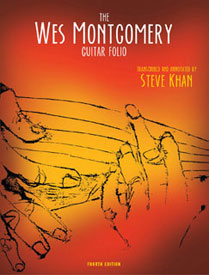 If you are curious, the book contains NO TAB, and the newly updated 4th Edition has just been printed, as of June, 2019. Though these transcriptions were mostly done during my college years at U.C.L.A. from 1965-69, the 1st Edition of the book was published in 1978, and it was a most fortunate happenstance that this even occurred. I still feel lucky to this day. I have had and have maintained a great working relationship with Laurie Goldstein, Wes' fiercely protective publisher. I hope that those interested will now find it easier to locate the book. Just click on the book cover and off you go!!! If you are curious, the book contains NO TAB, and the newly updated 4th Edition has just been printed, as of June, 2019. Though these transcriptions were mostly done during my college years at U.C.L.A. from 1965-69, the 1st Edition of the book was published in 1978, and it was a most fortunate happenstance that this even occurred. I still feel lucky to this day. I have had and have maintained a great working relationship with Laurie Goldstein, Wes' fiercely protective publisher. I hope that those interested will now find it easier to locate the book. Just click on the book cover and off you go!!!Had this sequence of albums: "PARTING SHOT"(2011), "SUBTEXT"(2014) and "BACKLOG"(2016) ended there, it would have almost seemed fated and logical in some sense, as I seem to make albums in groups of 3. But now that "PATCHWORK" has come into existence, I feel really great that this marks the 1st time that I have done a series of albums, with a particular concept, in a grouping of 4. Were circumstances to be different, I'm certain that I could go on and try to deepen the sense that a guitar can have a key role as a featured instrument within a Latin Jazz context, but I don't know that I am going to be the one to be able to do that. However, looking back over these four albums and the music that I have chosen to interpret, I think that there is a solid foundation that has been established on just how to craft Latin arrangements from classic tunes by players/composers that include: Thelonious Monk, Ornette Coleman, Wayne Shorter, Freddie Hubbard, Bobby Hutcherson, Joe Henderson, Andrew Hill, McCoy Tyner, Herbie Hancock, Greg Osby, and Keith Jarrett. This list does not include the standards covered from the "Great American Songbook" by some of our greatest composers/lyricists. If one has the desire, the inclination and the harmonic imagination, it is all possible. You just have to do it. My hope is still the same, and that is this. I am always hopeful that, in the not-too-distant future, a great guitarist, perhaps from the Caribbean or South America will take what I have done, and put to use all of the gifts that are theirs naturally to take these concepts of mine forward and create something truly amazing. What I have done can be done even better by someone who is much more knowledgable and gifted than I am!!! So, to whoever you might be - pick-up the mantle and run with it - as far as you can!!! You can do it!!! I believe in you!
[Photos: Steve Khan
Bobby Allende and Marc Quiñones Rubén Rodríguez and Rob Mounsey Dennis Chambers - all @ Sear Sound by Richard Laird] |